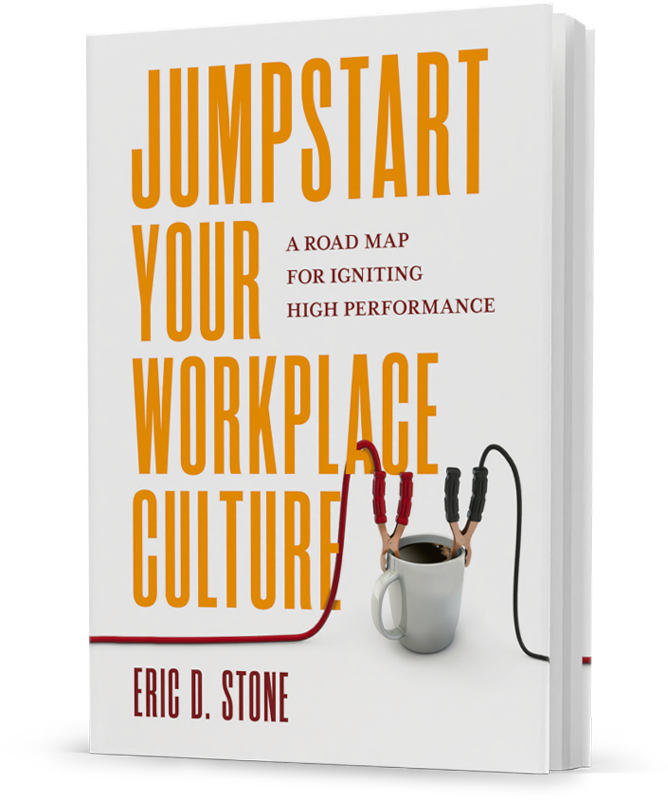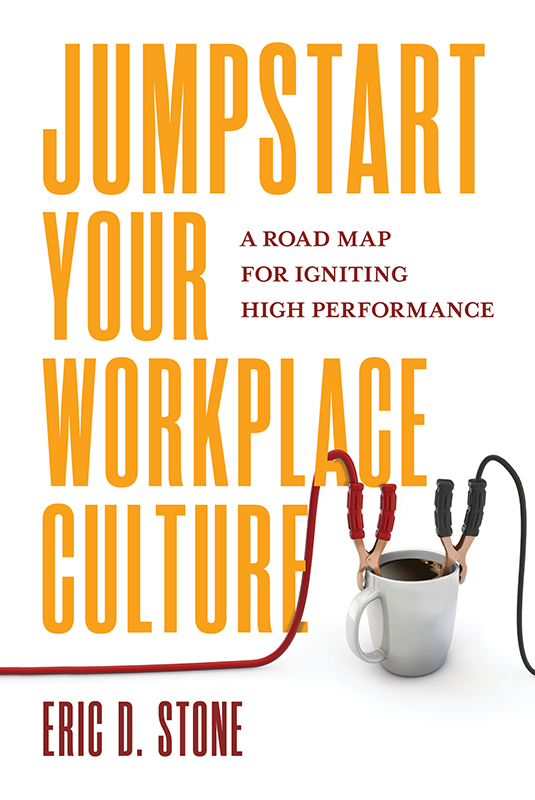Gauge your
company’s health
Hit the brakes on outdated methods
Ignite elite performance
Order Now

Available Now
“This book will change your impressions of what organizational culture is all about. Eric Stone breaks through the noise and provides a clear path to high performance by balancing high standards and character with the perfect mix of training and trust.”
Claude Silver, chief heart officer of Gary Vaynerchuk’s Vaynerx and Vaynermedia
Thousands of books have been written about leadership and workplace culture, but many rely too much on abstract philosophy and head-scratching jargon.
The Leaders of today need practical answers.
In Jumpstart Your Workplace Culture, Eric Stone breaks through the noise to give readers a practical road map for fostering a culture that yields results year in and year out. Influenced by his quarter-century of experience with one of America’s most beloved brands, the book is loaded with interviews from senior corporate executives as well as real-life examples and anecdotes.
With a distinctive approach that balances flexibility and accountability, Eric digs deep into his accumulated wisdom and experience to help readers know when—and how—to redirect their culture or take a new route. He equips you with everything you need to ignite and maintain a workplace that runs smoothly . . . and never again needs a jumpstart.
Order Now

Exclusive: Download the Free Workbook
- Looking to expand what you’ve learned in Jumpstart Your Workplace Culture?
- Ready to ignite your team and take them to the next level of performance?
- Try the hands-on assessments, exercises, and activities in the Jumpstart Your Workplace Culture Workbook!

About Eric Stone
Create. Build. Elevate.
Eric D. Stone’s passion for business led him to an influential twenty-six-year career at the iconic rental car company Enterprise Holdings, where he quickly became one of the most decorated Regional Vice Presidents in the company’s history. His ability to connect and motivate employees from all different generations and demographics allowed his teams to sustain top-level results and a culture of pride.
Eric attributes much of this success to his ability to create, ignite, and elevate a high-performance culture—one that enabled him to lead his teams through challenges like 9/11, the Great Recession, the COVID-19 pandemic, and the Great Resignation—along with an extraordinary ability to adapt to the unexpected and help others do the same.
Eric retired from Enterprise in 2018 and founded Clear Path Ventures, which specializes in guiding young professionals and businesses as they navigate their path to success.
Eric has served on the boards of multiple community-focused nonprofits, which focus on providing strategies and resources to close the opportunity gap for marginalized groups.
Want to Learn More?
Listen to Eric Speak About Employee Engagement Below.
Advanced Praise for Jumpstart Your Workplace Culture
“Great insights and Eric was very knowledgeable sharing his experiences.”
The Game Changers Experience
“In the wake of the Great Resignation, maintaining a culture where everyone is engaged continues to be a challenge for many. With this book, Eric brings a real-life approach to building—and upholding—a culture that focuses on people as well as profits and growth. People are our most valuable asset, and the book is a reminder that culture eats strategy for lunch. If you don’t have a great culture in place, you won’t be in business for long. Buy the book and build the best road map for your organization.”
JEFFREY HAYZLETT, PRIMETIME TV AND PODCAST HOST, SPEAKER, AUTHOR, AND PART-TIME COWBOY
“Timeless and timely, Jumpstart Your Workplace Culture is a prerequisite for any leader who is trying to create a competitive advantage for their company. With a unique combination of coaching, guiding, and accountability, it’s an essential blueprint for any leader trying to build a high-performance organization.”
GARRY RIDGE, THE CULTURE COACH & CHAIRMAN EMERITUS, WD-40 COMPANY
“Eric Stone’s Jumpstart Your Workplace Culture is a great read! It offers real-world examples with practical advice feathered in to help leaders looking to transform their organization’s culture. It should be ‘top of the list’ for anyone interested in creating a positive and productive work environment.”
JAMES M. KERR, TOP 10 CULTURE CHANGE THOUGHT LEADER AND LEADERSHIP COACH
“A sweeping and authoritative plan for making corporate teams behave as organic wholes.”
Kirkus Reviews
“Eric was a phenomenal guest. His passion to help leaders drive a high performing workplace culture came through really clear and strong. I look forward to connecting with him again.”
Leading From the Middle
“Excellent guest!”
The KAJ Masterclass LIVE
“Providing a cutting-edge approach for leaders to measure the health of their organization, Eric Stone’s book is packed with practical techniques and light on theoretical abstracts, demonstrating that a highly engaged culture is the catalyst for top-level results.”
JOSH LINKNER, NEW YORK TIMES BESTSELLING AUTHOR, FIVE-TIME TECH ENTREPRENEUR, VENTURE CAPITAL INVESTOR
“This book will change your impressions of what organizational culture is all about. Eric Stone breaks through the noise and provides a clear path to high performance by balancing high standards and character with the perfect mix of training and trust.”
Claude Silver, Chief Heart Officer, Vaynex, Vaynermedia
Press
Eric Stone is available now for interviews and book-related events. Please contact Amplify Publishing Group marketing manager Heather at heather@amplifypublishing.com.






Assessment
Coming Soon
| Year 1 | Year 2 | Goal | |
| Employee Engagement i | |||
| Customer Service i | |||
| Employee Retention i | |||
| Values and Ethics i | |||
| Diversity Equity & Inclusion i | |||
| Profit or Growth i |
Employee Engagement
Gathering engagement data: Conduct a survey of eight to twelve questions using the Likert scale, but on the scale from “agree completely”—employees who go beyond their job description—to “agree somewhat”—employees who are strong and steady and do what’s asked—to “not sure,” to “disagree somewhat”—employees who suffer in silence and are passive—to “disagree completely”— unconscious or conscious sabotage. Examples include:
- I would recommend our company to my friends as an employer.
- I receive the support I need from my manager.
- I am proud of the work I do at the company.
Add the average percentage of “agree completely” results to get your engagement score. For example, if an average employee answers four out of twelve questions “agree completely,” then your engagement score is 33. For all surveys I suggest having a firm that specializes in such surveys prepare, administer, and tabulate them for you. They know all the most effective questions, not to mention that a survey from a third-party firm seems more objective to your people.
Customer Service
Gathering customer service data: Conduct a one-question sur-vey—”How satisfied are you with our company’s customer service?”—using the typical five-point Likert scale: completely satisfied, moderately satisfied, neutral, moderately dissatisfied, completely dissatisfied. The percentage of “completely satisfied” responses is your score. If 82 percent of customers respond “completely satisfied,” your score is 82 percent. A key component to all surveys is giving the individual taking the survey an opportunity to write in feedback and expand on a point for each question that’s asked. This is extremely valuable and allows for you and your team to pinpoint specific patterns that need sharpening.
Employee Retention
Gathering retention data: Simply take the percentage of your people retained during the period you’re reviewing. That’s easy.
Values and Ethics
Gathering values and ethics data: As with engagement, this survey should feature eight to twelve questions about your organizational values, using the Likert scale from “agree completely” to “disagree completely.” Sample questions include:
- “The actions of leadership reflect the company’s stated values.”
- “The organization applies its values consistently across all areas of the business.”
The average percentage of “agree completely” responses is your values score. For example, if the average employee answers eight out of twelve questions “agree completely,” then your values score is 66.
Diversity Equity & Inclusion
Gathering diversity data: First, calculate your diversity score using your MSA findings. Just look at the percentage of people over the age of twenty-one who live in your MSA and determine what percentage of them are women or people of color. This data is easy to get by contacting the US Census Bureau. Now look at the percentage of people in your workforce who are women or people of color, and compare the two numbers. Your diversity score is the difference, expressed as a percentage, between the number of your employees who are women or people of color and the women and people of color who reside in your MSA. For example, if people of color and women make up 50 percent of the people over twenty-one in your MSA, and 40 percent of your company’s workforce is women and people of color, your company is 80 percent as diverse as your MSA (40/50=80 percent). That’s your diversity score.
Conduct a survey on equity and inclusion. As with engagement and values and ethics, this survey should feature eight to twelve questions, using the Likert scale from “agree completely” to “disagree completely.” Sample questions include:
- “The organization has inclusive hiring, retention, and advancement policies.”
- “The organization is a welcoming environment for people of different ethnicities, orientations, and creeds.”
- “Are you able to bring up problems and tough issues?”
The average percentage of “agree completely” responses is your equity and inclusion score. For example, if the average employee answers nine out of twelve questions “agree completely,” then your equity and inclusion score is 75 percent. Finally, average your diversity score and your equity and inclusion score. If your diversity score is 80, and your equity and inclusion score is 75, that’s 155/2=77.5 percent. Rounding up, your DEI score would be 78.
Profit or Growth
We handle profit or growth (P/G) differently from the other critical components because the numbers can vary wildly. For a long-established company, a 10 percent boost in profitability can be huge, while a growing young company might routinely see revenue jumps of 200 percent a year. First, decide which metric you’re looking at: profit, revenue growth, or market share growth. Once you’ve done that, enter your data into the assessment tool.
Drop Eric A Line
Have questions? Ready to jumpstart your workplace culture? Want more information on the book? Contact Eric directly using the form below.